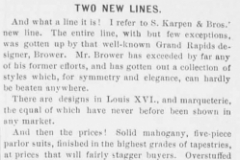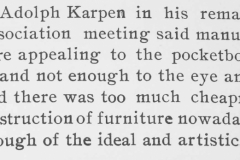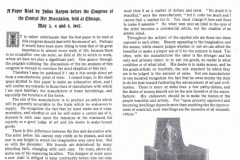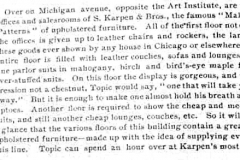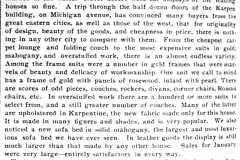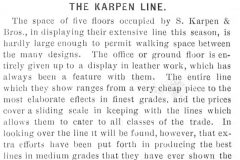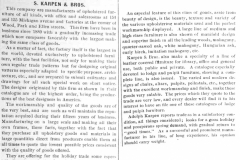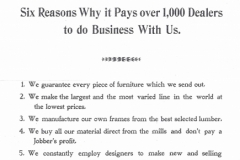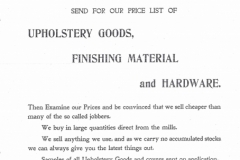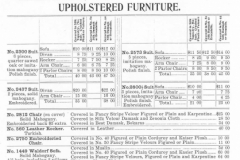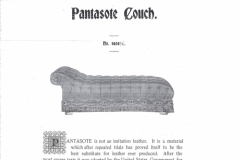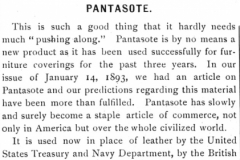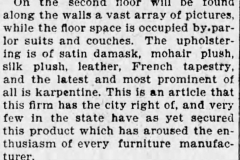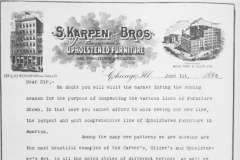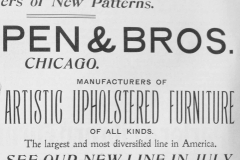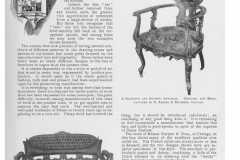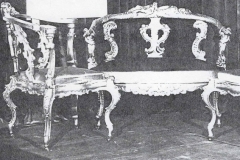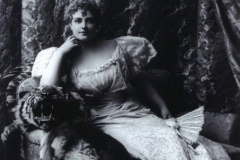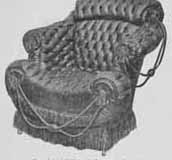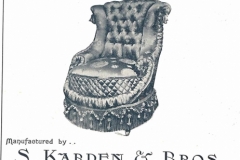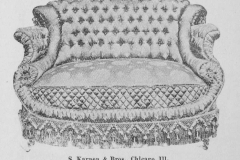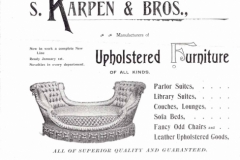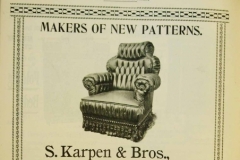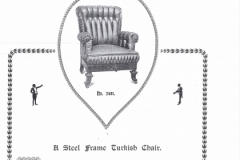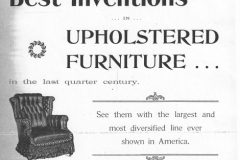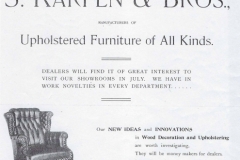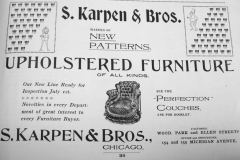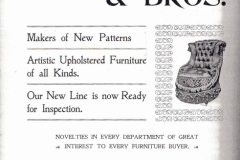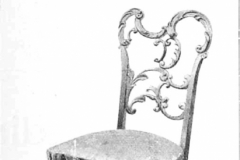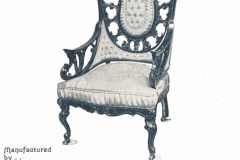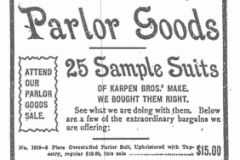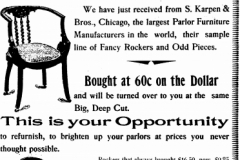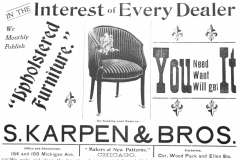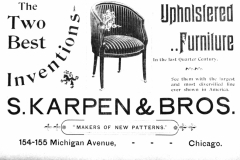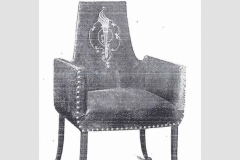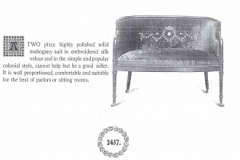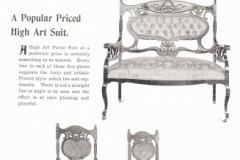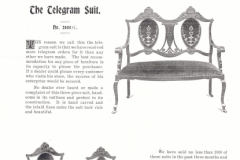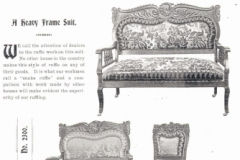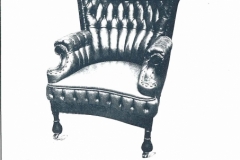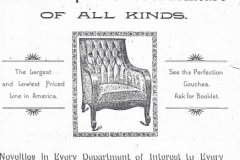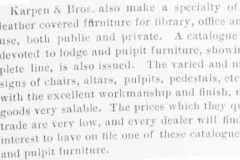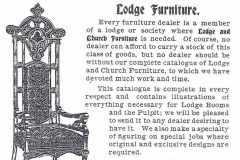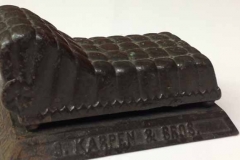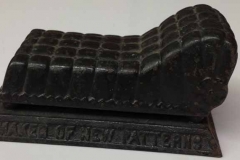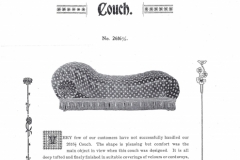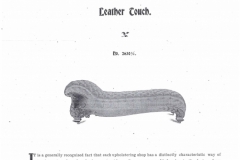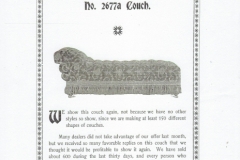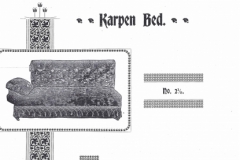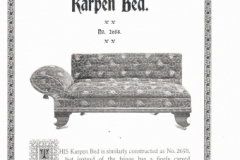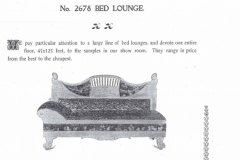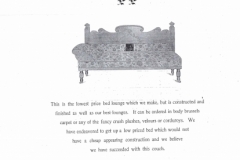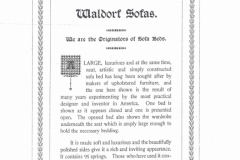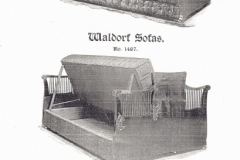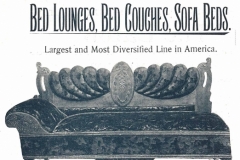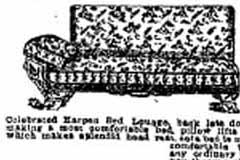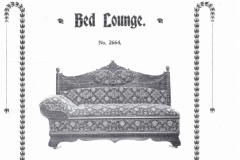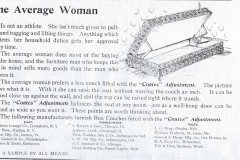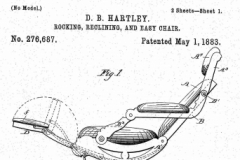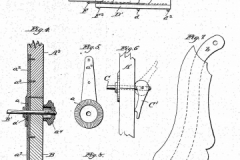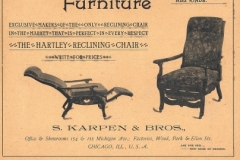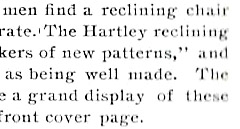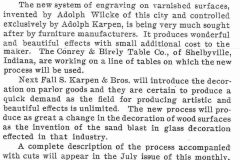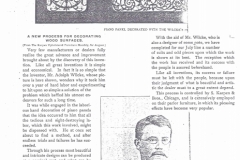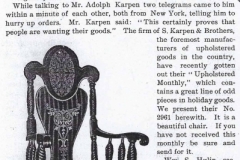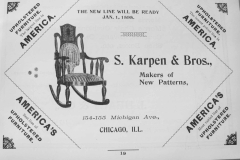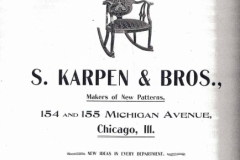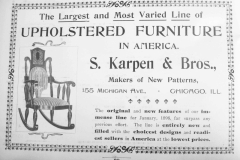Makers of New Patterns: 1894-1898
The workmanship and quality of the goods are of the very best, and are such as will maintain the reputation acquired during their fifteen years of business. — American Cabinet Maker and Upholsterer, November 2, 1895, 13.
Makers of New Patterns meant Makers of New Designs. Furniture design was paramount for Karpen Bros. At a convention, “Mr. [Adolph] Karpen did not agree with one of the other speakers of the evening who said that the styles in furniture were dictated by the American women through suggestions to the retailer. The speaker said that the styles and designs are originated by the manufacturers, and at no little expense.”[1]
Karpen Bros. used the services of outside designers. One of them, John Edward Brower (1859, Chicago-1914), worked for several Chicago and Grand Rapids, Michigan furniture companies and was considered to be one of the foremost furniture designers in America. A trade journal praised his efforts for Karpen Bros.:
“The designs originated by this firm as shown in their catalogue are of the highest order, being the productions of the best designers in America.” Their furniture lines were called “the production of the best designers in America.” [2]
Solomon Karpen concentrated on the quality of manufacturing. He strove for “superior finish in all the leading woods, mahogany, quarter-sawed oak, white mahogany, Hungarian ash, curly birch, imitation mahogany, etc.” [3] “The imitation mahogany goods made by this company are all made of birch and finished in such a way that an expert can hardly tell the difference. [According to Mr. Adolph Karpen] they had learned from experiment that no wood would take a better mahogany finish than birch.”[4]
Karpen Bros. set lofty artistic goals for its furniture lines. Adolph Karpen spoke about his concerns at a national furniture retailers convention in 1897:
Julius Karpen presented a speech to the Central Art Association at its three-day Congress with 500 participants held at the Art Institute, Chicago in May 1897.[5] “The Abuse of Art in Manufacture” analyzed the relationship between fine art and the decorative arts and the manufacturers’ role in educating the buying public. He quoted William Morris, the founder of the Arts and Crafts Movement, who criticized common design errors of the time. Julius shed light on the issues facing manufacturers in producing artistic and functional furniture.
Julius Karpen’s Speech on Furniture, 1897.
One furniture trade journal described the quality of Karpen Bros.’ 1895 line in detail:
Business Acumen
Business was paramount for Karpen Bros. Its sales and publicity copy was strong and positive:
The Karpen Upholstered Furniture Monthly published in June 1897 gave some sales information. The company sold “no less than 1500 of a three-piece suit” constructed of quarter sawed oak or imitation mahogany priced between $6 and $12 for each piece. They stated that they made “at least 150 different shapes of couches” and sold “about 600 during the last thirty days” of one style that was “pronounced” the “best and cheapest couch on the market.”[6]
An 1897 price list showed the product and price range offered to dealers. A chair constructed of imitation mahogany was priced at $ 4.25; a sofa bed was sold for $64.00. Prices varied by the quality of the fabric covering: the better-quality fabrics adding up to $5 to the cost.
As well as utilizing the usual coverings, Karpen Bros. used Pantasote, a new leather substitute. It began designing its own upholstery fabric which was named “Karpentine.” In retail store advertisements from 1894 onwards, “Karpentine” was listed, along side corduroy and velvet, as if it were a well-known fabric.
Karpen Bros. focused on attracting dealers to their new lines in its advertisements in the furniture trade journals. It included phrases like “the largest and most diversified line in America.”
Furniture Trade Journals
Karpen Bros.’ furniture pieces were being noticed by the editors of the furniture trade journals. The Decorator and Furnisher (published from 1882 to 1897 in New York City) featured carved pieces in its “Style in Furniture” editorial column:
Karpen Bros. featured in Decorator & Furnisher, 1896.
Another public relations achievement, Lillian Russell, a major star of the stage worldwide, used a Karpen Bros. suite in her Gay Nineties stage productions:
Furniture Lines
Turkish Furniture, 1894-1896:
Turkish Furniture- 1897-1898:
Parlor Furniture:
Embroidered Furniture:
Furniture, Not Mahogany:
Leather Furniture:
Lodge Furniture:
In the 1890s, fraternal lodges and churches were a growing market. A furniture trade journal reported:
“A [1895] catalogue especially devoted to lodge and pulpit furniture, showing a complete line, is also issued. The varied and modern designs of chairs, altars, pulpits, pedestals, etc., together with the excellent workmanship and finish, make these goods very salable. The prices which they quote to the trade are very low, and every dealer will find it to his interest to have on file one of these catalogues of lodge and pulpit furniture.”[7]
Lounges:
Sofa beds:
“We pay particular attention to a large line of bed lounges, and devote one entire floor, 45 x 125 feet, to samples our showroom.”[8]
The Hartley Chair
Mechanical furniture was popular in this era, and Karpen Bros. offered some chairs in these styles. The Hartley “reclining, rocking, and easy” chair was patented in 1883 by D. Bert Hartley of Chicago.[9] It was manufactured by various companies. “This well-known house now [1895] controls by purchase all rights and title to the Hartley reclining chair in which they show many styles.”[10]
Wilcke Process Furniture
An innovation in the furniture industry in 1897 was kept a secret for months while Adolph hinted at its potential to change the industry: “we have to keep up our reputation as makers of new patterns; their trade always looks to us for something new.”[11]Adolph Karpen secured the exclusive control of a new, low cost process of wood decoration producing the effect of engraving, invented and patented by Adolph Wilcke.[12]
S. Karpen & Bros. in the late 1890s created new designs and market niches in a diversified marketplace.
- American Cabinet Maker & Upholsterer, May 8, 1897, 18. ↑
- American Cabinet Maker and Upholsterer, Nov. 2, 1895, 13. ↑
- American Cabinet Maker and Upholsterer, Nov. 2, 1895, 13. ↑
- American Cabinet Maker and Upholsterer , July 14, 1894, 19. ↑
- Chicago Daily Tribune, May 5, 1897. S. Karpen & Bros., Upholstered Furniture Monthly 2 (June 1897), [3-4]. The Henry Ford. ↑
- S. Karpen & Bros., Upholstered Furniture Monthly 2 (June 1897), [17], [21]. The Henry Ford. ↑
- American Cabinet Maker and Upholsterer, Nov. 2, 1895, 13. ↑
- S. Karpen & Bros., Upholstered Furniture Monthly 2 (June, 1897), [19]. The Henry Ford. ↑
- Hartley Patent US276687, May 1, 1883. ↑
- American Cabinet Maker and Upholsterer, Feb. 9, 1895, 17. ↑
- Furniture Trade Review and Interior Decorator, June 10, 1897, 61. ↑
- Furniture Trade Review and Interior Decorator, June 10, 1897, 61. ↑
